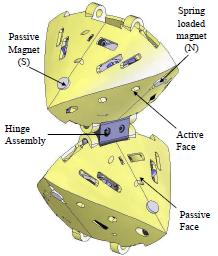Overview:
Consider a system consisting of many small programmable modules. A user could program this collection of programmable matter to form a desired tool such as a wrench. When finished, the user could reprogram the system to form a hammer or another desired tool. In order to form a wide range of shapes with good resolution, the system should consist of many miniature modules.
The Right Angle Tetrahedron Chain Externally Actuated Testbed (RATChET) system demonstrates external actuation as a method to facilitate miniaturization. Gravity is used as the external force to fold modules into the desired shape. The actuator in the RATChET module is designed for miniaturization: it’s constructed by planar fabrication and employs a solid state actuator.
To be truly versatile, a single collection of programmable matter modules should be capable of being reprogrammed to form arbitrary shapes. Experiments show that a chain of five RATChET modules can be programmed to form a desired shape and deterministically assembled by the external actuator. The chain is then manually disassembled, reprogrammed to form a different shape, and assembled to this second shape.

Hardware:
A 2 DOF hinge connects each pair of RATChET modules in the chain and provides a path for distributed power and communication wires. RATChET modules bond using neodymium magnets. A RATChET module has two passive faces each with a fixed magnet and two active faces each with a spring loaded magnet. Initially, modules hang in a chain with active face magnets retracted.
The root RATChET module (attached to manipulator) is programmed to form the desired shape. The program specifies for each module which of its two active faces bonds to its neighbor below.
To bond with the neighboring module below, a module releases the suppressed magnet on the desired active face. A latch attached to a compliant return spring holds each active magnet within the module. To release the magnet, the module activates a Shape Memory Alloy (SMA) wire retracting the latch and allowing the active magnet to spring to the surface.
A 2 DOF external manipulator comprising a CKBot and a CKBot motor module provides external actuation to assemble the shape. A planner determines the motion path for the external actuator such that the force of gravity is used to fold the desired RATChET configuration sequentially from the root module.
Movies:
ratchet_auto_hex_demo_m.mov
ratchet_auto_line_demo_m.mov
Related Projects:
XBot: The XBot system is a modular self-reconfigurable robot that uses inertia as the external actuation force to move modules during reconfiguration.
CKBot: The CKBot system is a versatile modular robot developed at the ModLab.
Related Papers:
-
![[PDF]](https://www.modlabupenn.org/wp-content/plugins/papercite/img/pdf.png)
![[DOI]](https://www.modlabupenn.org/wp-content/plugins/papercite/img/external.png) P. J. White, C. E. Thorne, and M. Yim, “Right angle tetrahedron chain externally-actuated testbed (ratchet): a shape changing system,” in Proc. of asme intl. design engineering technical conferences & computers and information in engineering conference idetc/cie, San Diego, CA, USA, 2009.
P. J. White, C. E. Thorne, and M. Yim, “Right angle tetrahedron chain externally-actuated testbed (ratchet): a shape changing system,” in Proc. of asme intl. design engineering technical conferences & computers and information in engineering conference idetc/cie, San Diego, CA, USA, 2009.
[Bibtex]@inproceedings{PJW:CET:MY:09, title={Right Angle Tetrahedron Chain Externally-actuated Testbed (RATCHET): A Shape Changing System}, author={P. J. White and C. E. Thorne and M. Yim}, BookTitle = {Proc. of ASME Intl. Design Engineering Technical Conferences \& Computers and Information in Engineering Conference IDETC/CIE}, year={2009}, pdf={http://modlab.seas.upenn.edu/publications/white_detc2009-87657.pdf}, address={San Diego, CA, USA}, doi={10.1115/DETC2009-87657}, }